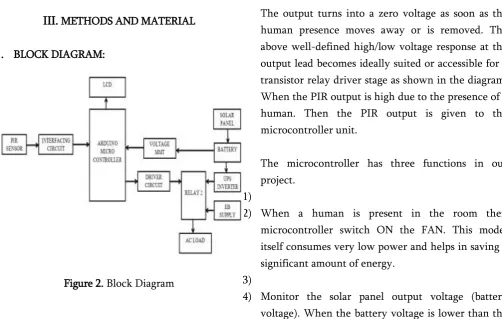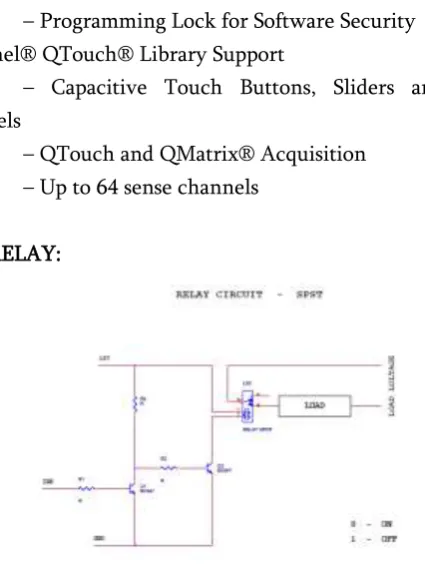DOI : https://doi.org/10.32628/CSEIT183848
Renewable Energy Based Intelligent Lighting and Cooling
System Using PIR Sensor
Dr. P. Avirajamanjula*1, Gnanaseharan A2 , Vijayan M2
1Professor, Department of Electrical and Electronics Engineering, PRIST University, Tanjore, Tamil Nadu,
India
2P.G Scholar, Power Systems, PRIST University, Tanjore, Tamil Nadu, India
ABSTRACT
The model is developed for reducing the wastage of electricity due to careless and improper switching in households, schools, colleges and offices etc. It saves energy by maximizing the use of daylight. This is an automatic system which employs solar energy through PV. The system is capable of controlling fans in a room depending upon human thermal radiation. The parameter is measured through sensor and the controlling is done by microcontroller. PIR sensor detects the occupancy in the room. If human is present in the room then microcontroller switch ON the FAN. This model itself consumes very low power and helps in saving a significant amount of energy. The model can be applied to government offices, private firms, residential buildings, schools; colleges etc. so as to avoid the wastage of electricity also reduces our dependence on conventional energy and will help in conserving energy.
Keywords : PIR switch, Renewable sources, PV array, online UPS
I.
INTRODUCTIONA smart solar emergency lamp is not a normal lamp which is used in our day to day life.This is efficiently utilising both the power sources A.C. and Solar energy on the basis of requirement. In which contains a photovoltaic solar panel, an A.C source, an LED lamp, a PIR motion detector and a rechargeable battery. Solar lamps are used for generally illumination where centrally generated power is not conveniently or economically available. The world cannot depend onlyon fossil fuels for the energy requirements for very long time. Fossil fuel is limited on our earth, in which speed it uses, one day come when it will end.
When we burnt them, they produce air pollution which is biggest factor of global warming, acid rain,
health issue and others. Therefore, we must choose renewable source of energy such as solar energy, wind energy, tidal energy, geothermal heat and others. In this our research we choose solar energy which is photovoltaic system and ideal for providing electrical power. With the help of this power, we light the lamp and run our home appliances. One of the biggest advantages of solar energy is non-polluting. Other various advantages such as noise free and ecofriendly. It does not harm the natural resources and very cheap for long term usages.
due to which the battery will not proper charge. We use a transformer and full wave rectifier which have been charge the battery using microcontroller controlled relay switch. With the help of this technique we can be charged the battery whenever mains power is available.
Figure 1. System diagram
This smart solar lamp also having a special function of “Motion Detecting”. We used passive infrared (PIR) sensor, which automatically switch on the device when any living object comes closer to it. So whenever any stranger person will try to be closer to the solar lamp then the sensor starts making a noise through a speaker and we can get to know who is the person in the installed area of lamp. The history of modern lamp was started through Thomas Edison which was invent electric light. We use LED lamp which is two-lead semiconductor light source. It is p-n jup-nctiop-n diode, whep-n a suitable voltage applied to semiconductor. LEDs have many advantages over incandescent light sources such as low power consumption, long life, smaller size, faster switching and others.
The solar panel is primary source of energy in this project. It provides D.C current to the
monitoring circuit where it is used to charge the battery. Basically three types of solar panel available they are single crystalline, polycrystalline and thin film. We used single crystalline in this project. It is the most efficient and its efficiency is approx. 15-18%. A large chunk of silicon crystal makes it different from others. The solar panel work in three steps they are following: follow in a single direction.
c) Generation of current in a solar cell, known as the “light-generated current” or direct current (D.C) electricity.
II.
LITERATURE SURVEYPower Consumption Rate of Bangladesh The U.S. Energy Information Administration provides data for Bangladesh from 1980 to 2014. The average value for electricity consumption of Bangladesh during that period was 15.1 billion kilowatt-hours with a minimum of 1.8 billion kilowatt-hours and a maximum of 46.17 billion kilowatt-hours in 2014.
2.1 Review of Relevant projects:
Arduiono as well. We have got additional knowledge from particular publication about human sensing device. We have gathered knowledge about our proposed system from some article as well which has been published by an organization.
2.2 Discussion about Automatic speed control fan using various components:
We gathered some knowledge from some
publications regarding our project. We have discussed here the main principal of those relevant projects. Automatic Temperature Controlled Fan Using Thermistor In this paper for sensing the temperature Thermistor has been used. Here also described that how the speed of a fan can be controlled, based on temperature sensor. A sensor is a type of transducer. In a broader sense, a transducer is sometimes defined as any device that converts energy from one form to another. Besides that, the component that made up the temperature sensor is known as Thermistor.
III.
METHODS AND MATERIAL1. BLOCK DIAGRAM:
Figure 2. Block Diagram
2. BLOCK EXPLANATION:
The PIR module has three terminals, the right one is the ground terminal, center one is the positive +3.3V or +5V, and the left terminal is the responsive output lead of the device. When the particular assigned (+) and (-) terminals of the PIR device are connected to the specified supply voltages, the device instantly becomes responsive and begins "thinking".
No human presence or motion should be created in front of the unit's lens during this initial switch ON period for about a minute or so, until the device locks ON and puts itself into an alert or a ready stand by position.
The unit now becomes ready and responds to even the slightest human motion or presence in front of its lens by generating a positive supply at its output terminal; this high at its output terminal persists as long as a human presence is detected within a radial range of around 20 meters in front of the PIR device.
The output turns into a zero voltage as soon as the human presence moves away or is removed. The above well-defined high/low voltage response at the output lead becomes ideally suited or accessible for a transistor relay driver stage as shown in the diagram. When the PIR output is high due to the presence of a human. Then the PIR output is given to the microcontroller unit.
The microcontroller has three functions in our project.
1)
2) When a human is present in the room then microcontroller switch ON the FAN. This model itself consumes very low power and helps in saving a significant amount of energy.
3)
preset value then the microcontroller turn the EB supply to the load. Voltage measurement circuit is used for measure the battery voltage and then the microcontrollers display the voltage level.
When the battery voltage is greater than or equals to the preset value then the microcontroller turn the solar supply to the load.
3.1 PIR SENSOR:
The PIR sensors are more complicated than the other sensors as they consists of two slots. These slots are made of a special material which is sensitive to IR. The Fresnel lens is used to see that the two slots of the PIR can see out past some distance. When the sensor is inactive, then the two slots sense the same amount of IR. The ambient amount radiates from the outdoors, walls or room, etc. When a human body or any animal passes by, then it intercepts the first slot of the PIR sensor. This causes a positive differential change between the two bisects. When a human body leaves the sensing area, the sensor generates a negative differential change between the two bisects. The infrared sensor itself is housed in a hermetically
sealed metal to improve
humidity/temperature/noise/immunity. There is a window which is made of typically coated silicon material to protect the sensing element.
Figure 3. PIR sensor working
In the above segment, we have learned the pin outs of a PIR sensor, now let‟s move on to study a simple application of the PIR sensor. The below diagram depicts
a motion detector PIR sensor circuit
. In the presence of a human IR energy or radiation, the infrared sensor detects the energy and immediately converts it into minute electrical pulses, enough to activate thetransistor BC547
into conduction and to make its collector go low.3.2 SOLAR PANEL:
Figure 4. Solar panel
A photovoltaic system, also PV system or solar power system, is a
power system
designed to supply usablesolar power
by means of photovoltaic‟s. It consists of an arrangement of several components, includingsolar panels
to absorb and convert sunlight into electricity, asolar inverter
to change the electriccurrent from DC to AC, as well
3.3 BATTERY:
CAPACITY: 12V LEAD ACID BATTERY
Figure 5. Lead acid battery
The lead-acid battery was invented in 1859 by French physicist Gaston Planet and is the oldest type of rechargeable battery. Despite having a very low energy-to-weight ratio and a low energy-to-volume ratio, its ability to supply high surge currents means that the cells have a relatively large power-to-weight ratio. These features, along with their low cost, make it attractive for use in motor vehicles to provide the high current required by automobile starter motors. As they are inexpensive compared to newer technologies, lead-acid batteries are widely used even when surge current is not important and other designs could provide higher energy densities. Large-format lead-acid designs are widely used for storage in backup power supplies in cell phone towers, high-availability settings like hospitals, and stand-alone power systems. For these roles, modified versions of the standard cell may be used to improve storage times and reduce maintenance requirements. Gel-cells and absorbed glass-mat batteries are common in these roles, collectively known asVRLA (valve-regulated lead-acid) batteries.
3.4 ARDUINO MICROCONTROLLER:
The Atmel® picoPower® ATmega328/P is a low-power CMOS 8-bit microcontroller based on the
AVR® enhanced RISC architecture. By executing powerful instructions in a single clock cycle, the ATmega328/P achieves throughputs close to 1MIPS per MHz. This empowers system designer to optimize the device for power consumption versus processing speed.
Figure 6. Arduino pin diagram
Features:
High Performance, Low Power Atmel®AVR® 8-Bit Microcontroller Family
• Advanced RISC Architecture – 131 Powerful Instructions
– Most Single Clock Cycle Execution
– 32 x 8 General Purpose Working Registers – Fully Static Operation
– Up to 20 MIPS Throughput at 20MHz – On-chip 2-cycle Multiplier
• High Endurance Non-volatile Memory Segments – 32KBytes of In-System Self-Programmable Flash program Memory
– 1KBytes EEPROM – 2KBytes Internal SRAM
– Write/Erase Cycles: 10,000 Flash/100,000 EEPROM
– Data Retention: 20 years at 85°C/100 years at 25°C(1)
– Optional Boot Code Section with Independent Lock Bits
• True Read-While-Write Operation
– Programming Lock for Software Security • Atmel® QTouch® Library Support
– Capacitive Touch Buttons, Sliders and Wheels
– QTouch and QMatrix® Acquisition – Up to 64 sense channels
3.5 RELAY:
Figure 7. Relay Circuit
A relay is an electrically operated switch. Current flowing through the coil of the relay creates a magnetic field which attracts a lever and changes the switch contacts. The coil current can be on or off so relays have two switch positions and they are double throw (changeover) switches. Relays allow one circuit to switch a second circuit which can be completely separate from the first. For example a low voltage battery circuit can use a relay to switch a 230V AC mains circuit. There is no electrical connection inside the relay between the two circuits; the link is magnetic and mechanical. The time delaysettings of the relay is least time of change overfrom Solar to Electricity supply as well as to solar.
IV.CONCLUSION
This work is intended to design a simple and low cost multitasking hybrid solar fan, lamp with a motion detector. This is not only a simple solar lamp; it is having an additional feature of charging better by
mains supply if the weather is cloudy and having a motion detector sensor which ensure the safety. To design this system, we will use PIR sensor for motion detection and good materials at low cost. Our target is to design a system in such a way that its components will be able to provide better light in night and ensure the safety of nearby area. The whole system operates automatically. So it does not need any expert person to operate it. It is portable and not so expensive. This design has much more scope for future research and Alone Hybrid Generation System Combining Solar Photovoltaic and Wind Turbine with Simple Maximum Power Point Tracking Control. In Conf Rec. IEEE IPEMC, 2006. [5]. Automatic Room Light Controller with
bidirectional visitor counter | VOL-I Issue-4|
ISSN: 2395-4841
http://www.ijictrd.net/papers/IJICTRDV1I4005 .pdf
[6]. Altas. I, A. M. Sharaf, 2007 "A photovoltaic array (PVA) simulation model to use in Matlab Simulink GUI environment.” IEEE I-4244- 0632 -03/07.
Supplying DC Loads‟ IEEE TRANSACTIONS ON INDUSTRIAL ELECTRONICS, VOL. 60, NO. 8, AUGUST 2013.




